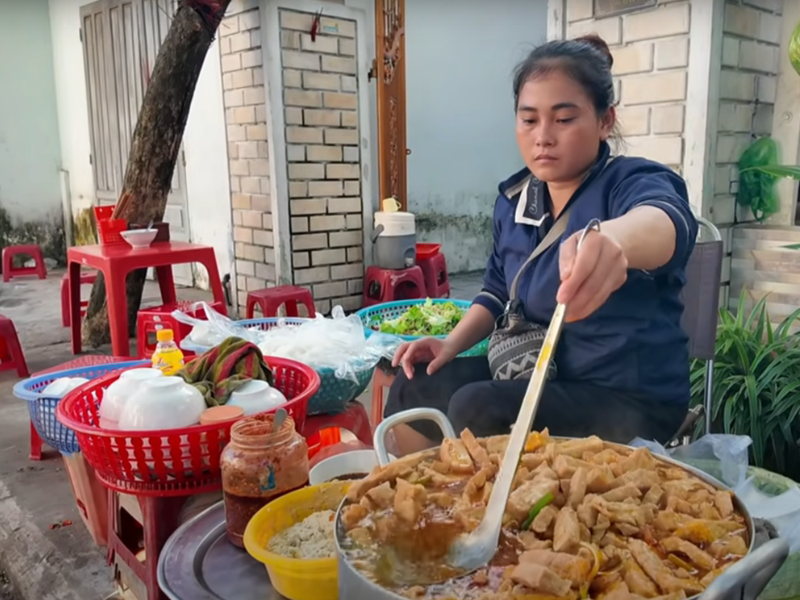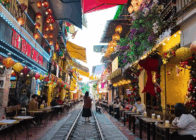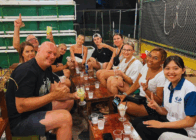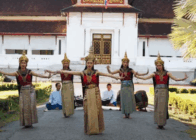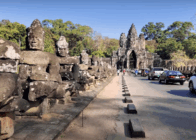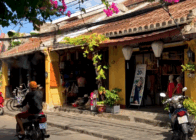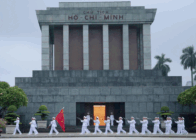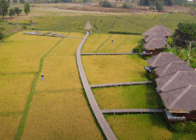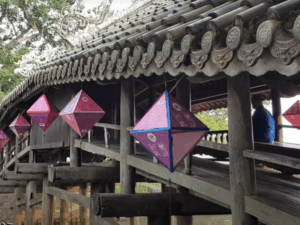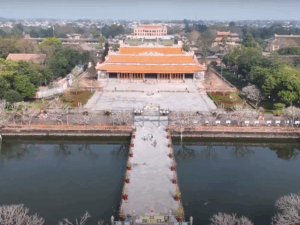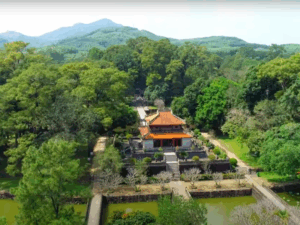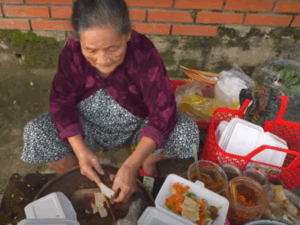Hue, the ancient capital of Vietnam, is not only well-known for its rich history and attractions but also for its distinctive cuisine. Hue cuisine is an exquisite combination of flavors, aromas, and colors, drawn local ingredients and generations of culinary traditions. If you are a food enthusiast, you must try the culinary delights of Hue, which will tantalize your taste buds and leave you craving for more. Join me on a culinary adventure, as we explore the flavors of Hue cuisine together.
Introduction to Hue Cuisine
Are you ready to take a tantalizing trip for your taste buds? Welcome to Hue cuisine, a beautiful legacy of Vietnamese culinary traditions. Nestled in the heart of Vietnam, Hue is renowned for its sophisticated, flavorful, and visually stunning cuisine. This ancient capital has long been cherished for its unique dishes that reflect the vibrant culture and rich history of the region.
Whether you are an avid foodie, a cultural explorer, or simply someone who enjoys discovering new flavors, Hue cuisine offers a delightful experience. In this guide, we’ll explore the distinct flavors, must-try dishes, and cultural significance of Hue cuisine. Prepare to be inspired by the stories behind these culinary treasures and find out where you can savor them.
The Flavors of Hue
Hue cuisine is a symphony of flavors, characterized by a harmonious balance of spicy, sour, salty, and sweet. This central Vietnamese city is known for its royal heritage, which is evident in the meticulous presentation and intricate preparation of its dishes.
Unique Taste Profiles
The dishes from Hue often feature bold and vibrant flavors. The use of lemongrass, shrimp paste, and chili peppers adds an aromatic and spicy kick, while ingredients like tamarind and lime introduce a tangy, refreshing twist. These contrasting tastes are thoughtfully balanced, resulting in dishes that are both exciting and satisfying to the palate.
Ingredients That Define Hue Cuisine
Key ingredients in Hue cuisine include fresh herbs, aromatic spices, and flavorful broths. Lemongrass, shrimp paste, fish sauce, and fermented bean paste are staples that contribute to the distinctive taste profiles of Hue dishes. Fresh ingredients such as mint, basil, coriander, and perilla leaves are commonly used to enhance the flavors and add a burst of freshness.
Royal Influence
The influence of the royal court is evident in the elaborate presentation and intricate preparation of Hue cuisine. Dishes are often served in small portions with beautiful garnishes, showcasing the artistry and attention to detail that defines this culinary tradition.
Must-Try Dishes
No exploration of Hue cuisine would be complete without sampling its iconic dishes. Here are some must-try delicacies that capture the essence of Hue’s culinary heritage.
Bún Bò Huế (Spicy Beef Noodle Soup)
Bún Bò Huế is arguably the most famous dish from Hue, known for its rich and spicy broth. Made with beef, pork, and lemongrass, this noodle soup is a flavorful concoction that warms the soul. The broth is simmered for hours with beef bones, fermented shrimp paste, and chili oil, resulting in a deeply savory and aromatic soup. Topped with tender slices of beef, pork hock, and fresh herbs, Bún Bò Huế is a must-try for any food enthusiast.
Nem Lụi (Grilled Minced Pork on Lemongrass Skewers)
Nem Lụi is another popular dish, featuring minced pork marinated with lemongrass, garlic, and spices, then grilled to perfection on lemongrass skewers. The smoky and savory flavor of the grilled pork is complemented by the fragrant lemongrass, creating a delightful combination. Nem Lụi is typically served with rice paper, fresh herbs, and a dipping sauce made of peanut and fermented bean paste.
Bánh Bèo (Steamed Rice Cakes)
Bánh Bèo are delicate steamed rice cakes topped with savory ingredients like minced shrimp, pork cracklings, and scallion oil. These bite-sized treats are served with a side of fish sauce for dipping. The soft and chewy texture of the rice cakes, paired with the savory toppings, makes Bánh Bèo a delightful appetizer or snack.
Cultural Significance
The cuisine of Hue is deeply intertwined with the region’s history, geography, and culture. Understanding the cultural significance of Hue cuisine provides a richer appreciation of its flavors and traditions.
Historical Roots
Hue was the imperial capital of Vietnam during the Nguyen Dynasty, and its cuisine reflects the grandeur and sophistication of the royal court. The culinary traditions of Hue have been passed down through generations, preserving the meticulous techniques and intricate presentations that were once reserved for royalty.
Geographical Influence
Situated near the Perfume River and surrounded by lush landscapes, Hue benefits from an abundance of fresh ingredients. The fertile land and proximity to the sea provide a diverse range of produce, seafood, and herbs that are integral to Hue cuisine. The region’s unique geography contributes to the distinct flavors and ingredients that set Hue dishes apart.
Cultural Practices
The people of Hue take great pride in their culinary heritage, and food plays a central role in cultural celebrations and daily life. Traditional cooking methods and recipes are carefully preserved, and meals are often shared with family and friends as a way to strengthen social bonds. Festivals and ceremonies frequently feature elaborate feasts, showcasing the artistry and cultural significance of Hue cuisine.
Where to Experience Hue Cuisine
For an authentic culinary adventure, exploring the local eateries, street food stalls, and high-end restaurants in Hue is a must. Here are some recommendations for where to savor the best of Hue cuisine.
Local Eateries
Hue is home to numerous family-run restaurants that offer traditional dishes prepared with love and care. Places like Hanh Restaurant and Lien Hoa Vegetarian Restaurant are known for their authentic flavors and warm hospitality. These local gems provide a glimpse into the rich culinary traditions of Hue, allowing visitors to experience the true essence of the cuisine.
Street Food Stalls
The vibrant street food scene in Hue is a testament to the city’s culinary diversity. Street vendors and market stalls offer a wide array of delicious treats, from Bún Bò Huế to Bánh Bèo. The Dong Ba Market is a popular destination for food enthusiasts, where you can sample a variety of local specialties and immerse yourself in the lively atmosphere.
High-End Restaurants
For a more upscale dining experience, Hue boasts several high-end restaurants that elevate traditional dishes with modern twists. La Residence Hue Hotel & Spa and Ancient Hue Garden Houses are renowned for their exquisite cuisine and elegant settings. These establishments showcase the artistry and refinement of Hue cuisine, providing a memorable dining experience.
Promoting Sustainability
Supporting local businesses and sustainable food practices is essential for preserving the authenticity of Hue cuisine. By choosing to dine at family-run restaurants and street food stalls, you contribute to the local economy and help maintain the cultural heritage of Hue.
Supporting Local Farmers
Many of the ingredients used in Hue cuisine are sourced from local farmers and producers. Choosing to support these farmers not only ensures the freshness and quality of the ingredients but also promotes sustainable agricultural practices. By buying locally, you help sustain the livelihoods of farmers and preserve the traditional farming methods that have been passed down through generations.
Reducing Food Waste
Sustainability in the culinary world also involves reducing food waste. Hue cuisine is known for its resourcefulness, utilizing every part of an ingredient to create delicious and innovative dishes. By adopting similar practices, such as composting food scraps and repurposing leftovers, you can contribute to a more sustainable food system.
Ethical Dining
When dining out, consider choosing restaurants and eateries that prioritize ethical and sustainable practices. Look for establishments that source their ingredients locally, use eco-friendly packaging, and support fair labor practices. By making conscious dining choices, you can enjoy the flavors of Hue cuisine while promoting a more sustainable and ethical food industry.
Conclusion
Hue cuisine is a celebration of flavors, history, and culture that offers a truly unique culinary experience. From the bold and vibrant taste profiles to the intricate presentations, every dish tells a story of the region’s rich heritage. Whether you’re a food enthusiast, traveler, or cultural explorer, Hue cuisine invites you to savor the artistry and tradition that define Vietnamese gastronomy.
We encourage you to explore the diverse and delicious world of Hue cuisine, both in Vietnam and through your own kitchen adventures. Share this post with fellow food lovers and join us in celebrating the flavors and cultural significance of this remarkable cuisine.
- The Best Exotic Vietnam – 16 Days / 15 Nights (75 views)
- Uncover Cambodia’s Hidden Charms 6 Days / 5 Nights (69 views)
- Top Vietnam Tour Operators – The Ultimate Guide to the Best Tour Companies for Vietnam (37 views)
- Seamless Cruise: Halong Bay to Da Nang – Fostering smooth travel experience from Halong Bay to Da Nang. (36 views)
- Vietnam Culinary Tour: Your Definitive Guide to a Food Lover’s Journey (34 views)

